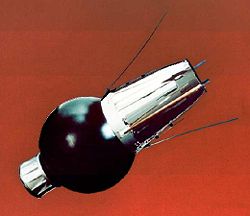- Ōsumi (satellite)
-
Ōsumi 
Operator Institute of Space and Aeronautical Science, University of Tokyo (now part of JAXA) Mission type Earth science Satellite of Earth Launch date February 11, 1970 at 04:25 UTC Launch vehicle Lambda 4S-5 Orbital decay August 2, 2003 COSPAR ID 1970-011A Mass 24.0 kg[1] Power 10.3 watt[1] Orbital elements Eccentricity .262379[2] Inclination 31.0°[2] Apoapsis 5,140 km[2] Periapsis 350 km[2] Orbital period 144.0 minutes[2] Ōsumi (or Ohsumi) is the name of the first Japanese artificial satellite put into orbit, named after the Ōsumi Province in the southern islands of Japan. It was launched on February 11, 1970 at 04:25 UTC with a Lambda 4S-5 rocket from Uchinoura Space Center by Institute of Space and Aeronautical Science, University of Tokyo, now part of the Japan Aerospace Exploration Agency (JAXA). Japan became the fourth nation after the USSR, USA and France to release an artificial satellite into successful orbit.
Parameters
The Ōsumi satellite weighed 24.0 kilograms.[1] It orbited the Earth with a perigee of 323 km and an apogee of 2,440 km, and with an inclination of 31.0°.[3] Ōsumi decayed from orbit and burned up in the atmosphere on August 2, 2003.[4]
References
- ^ a b c "Ohsumi". NASA NSSDC Master Catalog. NSSDC, NASA. http://nssdc.gsfc.nasa.gov/nmc/spacecraftDisplay.do?id=1970-011A. Retrieved 2008-02-12.
- ^ a b c d e "Trajectory Details". NASA NSSDC Master Catalog. NSSDC, NASA. http://nssdc.gsfc.nasa.gov/nmc/spacecraftOrbit.do?id=1970-011A. Retrieved 2008-02-12.
- ^ "Osumi". Encyclopedia Astronautica. Astronautix. http://www.astronautix.com/craft/osumi.htm. Retrieved 2008-03-02.
- ^ "SPX-598". SPACEWARN Bulletin. NSSDC, NASA. http://nssdcftp.gsfc.nasa.gov/miscellaneous/spacewarn/spx.598. Retrieved 2008-03-02.
External links
- Official Osumi webpage
- Image of Osumi: Kiwi-Osumi-image
Japanese space program Organizations Weather observation CompletedHimawari (1 · 2 · 3 · 4 · 5)In operationIn orbitPlannedHimawari-8 · Himawari-9Earth observation CompletedIn operationPlannedCommunications,
broadcasting and
positioningCompletedSakura (1 · 2a · 2b · 3a · 3b) · Yuri (1 · 2a · 2b · 3a · 3b) · BS(2X · 3H · 3N) · Kakehashi · Superbird (A · A1 · B1 · A2) · JCSAT(1・2・3・R) · N-STAR (a · b) · Kirari · MBSatIn operationPlannedEngineering tests CompletedIn operationPlannedPETSAT · SDS-4CancelledSmartSat-1Private miniaturized satellites CompletedIn operationPlannedWNI satellite · Horyu (1 · 2) · SPROUT · PROITERES · TSUBAME · QSAT-EOS · SOMESAT · RAIKO · FITSAT1 · WE WISHAstronomical observation CompletedIn operationPlannedUnmanned lunar and
planetary explorationCompletedIn operationAkatsuki · IKAROSFailedNozomi · Shin'enPlannedCancelledReconnaissance CompletedIn operationIGS (Optical 1 · Optical 2 · Optical 3 · Optical 4)PlannedIGS (Experimentally Optical 5 · Optical 5 · Optical 6 · Rader 3 · Rader 4 · Rader 5 · Rader 6)Human spaceflight CompletedH-II Transfer Vehicle (1 · 2)In operationPlannedCategories:- Artificial satellites formerly orbiting Earth
- Japanese space program
- Japanese satellites and space probes
- Spacecraft stubs
Wikimedia Foundation. 2010.
